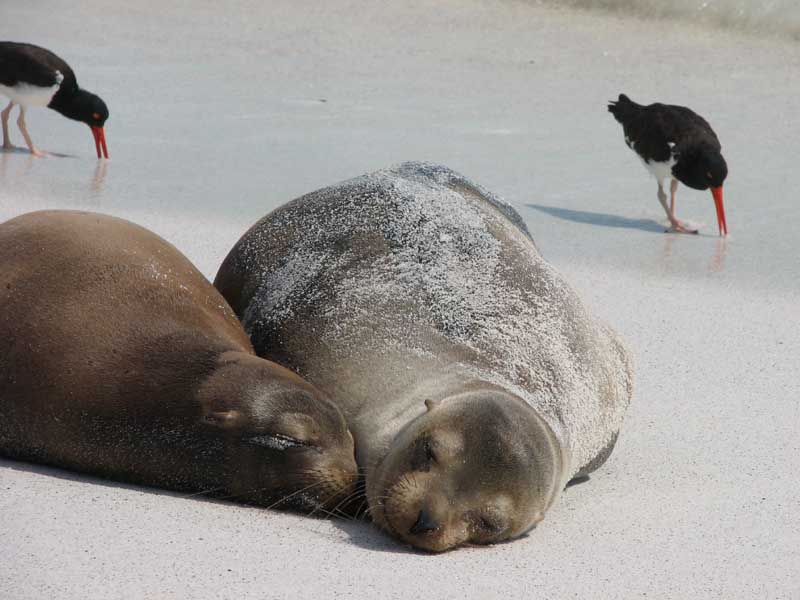
We ate breakfast outside this morning before leaving for an excursion to the beach at Gardner Bay . It was a very long beach , with very fine white sand and a ton of sea lions. Crystal waded out in the ocean while Justin walked up and down the beach taking video and pictures of the sea lions. Some of the sea lions were rolling around in the sand, others were rolling around in the crashing waves, but the majority of them were just sleeping on the beach. One of the British ladies got a little too close to one of them, and it chased her up the beach. We had no idea she could move that fast. In addition to the sea lions, there were some oystercatchers as well, and also some pelicans and some blue-footed boobies out of the water diving in for fish. Christian got his 2-hour break for the week, relaxing on the beach. Willy got his weekly exercise, jogging up and down the beach. Some people snorkeled, but we figured since we were going snorkeling right after we got back from the beach that might be a bit much.


In the morning, a bunch of people made a special request that in addition to the regular snorkeling excursion, which was scheduled to last a little over an hour, there also be a shorter excursion for people that wanted to go for only 20 minutes or so. They kept pestering Christian and the guides, who finally relented. To our shock, however, when we were boarding the panga for the longer excursion, one of the most vocal advocates for the short excursion was actually taking ours. Apparently some people just want what they can't have.
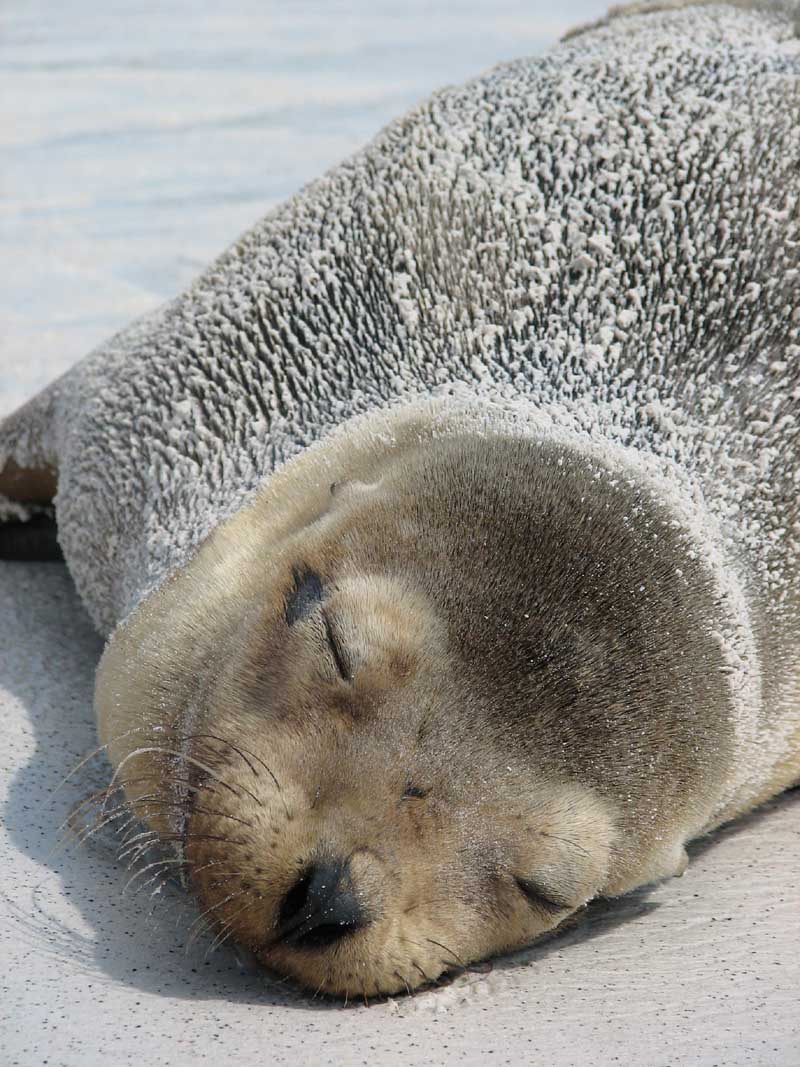
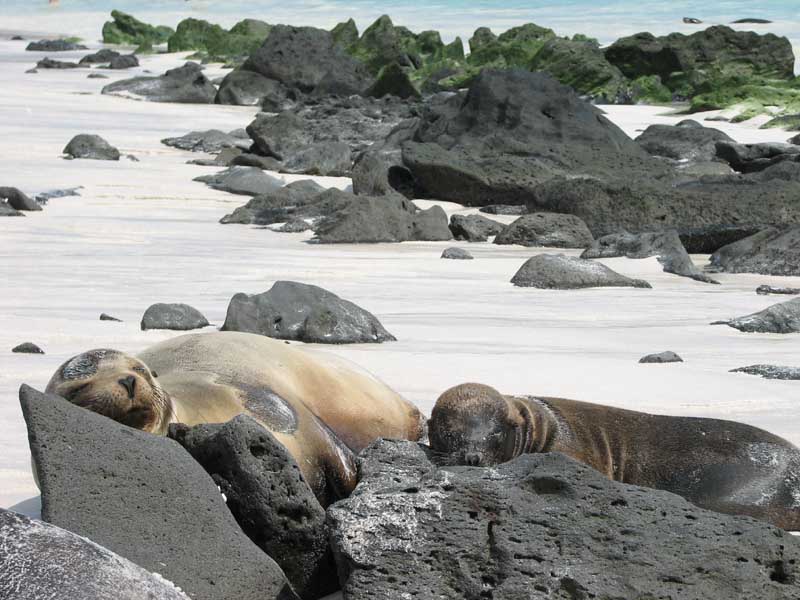
The water was unbelievably clear. We probably could have seen down 30 feet if the water was that deep. As it was, the depth was between 3 and 15 feet deep. There were fish everywhere, including a bright yellow puffer fish. There was a also a ton of coral and starfish, including some huge red starfish. After we swam all the way around the small islet, we got back into the pangas to go to a second spot. The hope was that we'd find a spot with some sea lions. Once we got to the spot, however, there was no evidence of sea lions. We figured that since it was our last full day and our last chance to snorkel, though, we should get in anyway. It was well worth it. There was a small cave that we snorkeled into, and inside the cave we saw a sea lion. And then another one and another one. All told, there were probably 6 to 12 sea lions in there. They were swimming all around us while we were swaying back and forth in the surf. One of the people with us, Gary, was adjusting his fin when he temporarily dropped it. As he went to grab it, one of the sea lions grabbed it and swam off with it, into a very small cave that we could not snorkel into. All of us were laughing, including the guides. Fortunately one of the sea lions brought it back out about 5 minutes later and Giovanni snatched it from the sea lions. It was probably the best snorkeling excursion of the week.
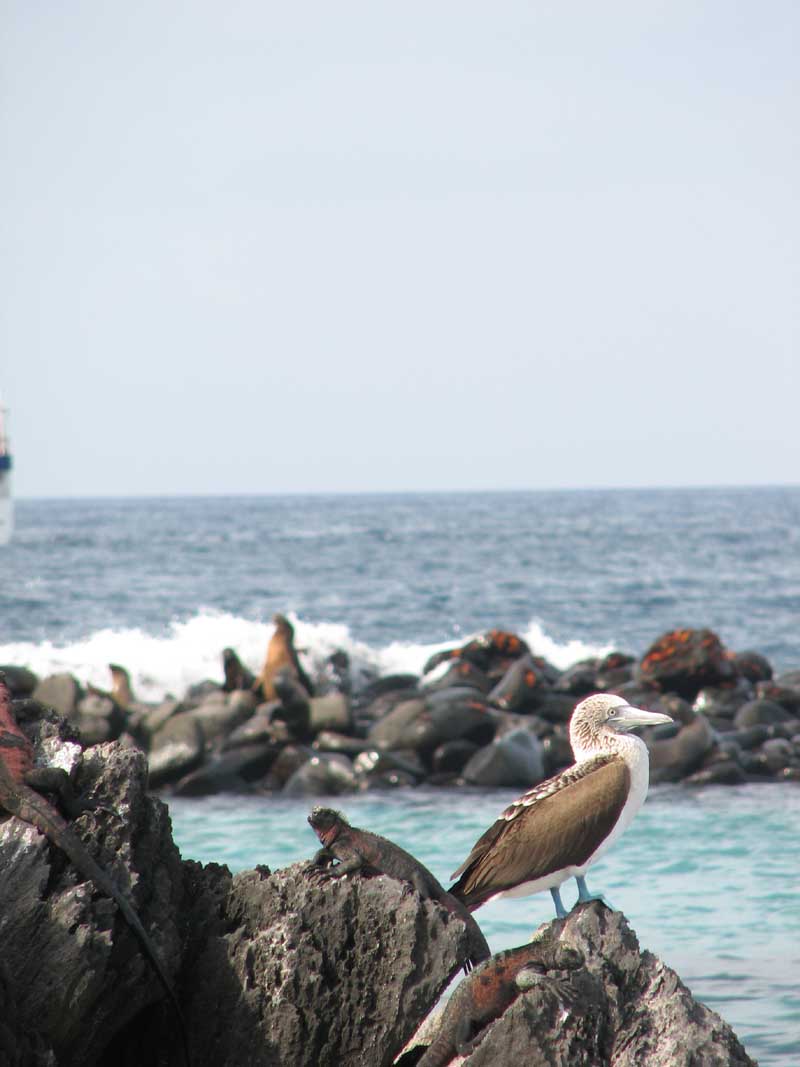
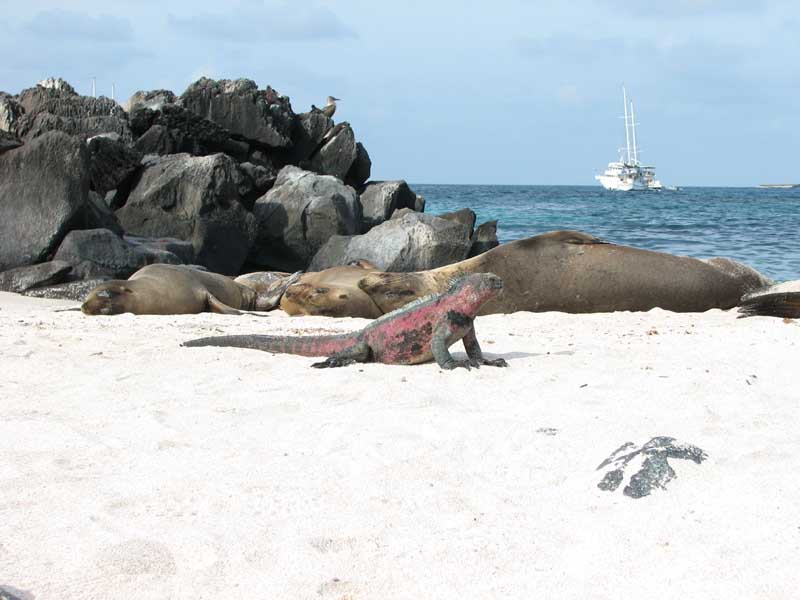
We came back to the boat and had lunch with the three British people we'd had lunch with a couple times, plus Martha and her daughter Kate. Giovanni also joined us, and we talked about medical care in the Galapagos. The short story is not to get sick or injured in the Galapagos. There is only one decent doctor (aside from whatever doctor may be on your ship), and if you need some special medication it has to come from Quito, often via the U.S.

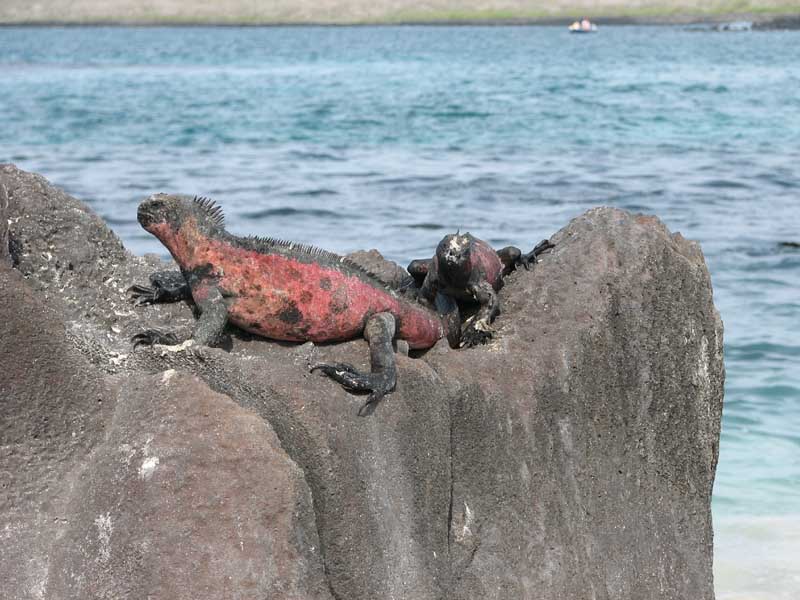
We packed a little bit before our afternoon excursion, which again was not well attended. And again, those who did not go missed out. There was some good cloud cover, and the trade winds were blowing, so it was quite comfortable. Also, the walk was very nice as well. We saw more marine iguanas, but instead of being black, these ones were red and green. They're the same species, but these ones on Espanola, for whatever reason, turn red and green for mating season. We also saw quite a few blue-footed boobies, including some doing mating rituals. There were also Nazca boobies, tropic birds, swallow-tailed gulls, and two hawks. Interestingly, the female hawks are larger than the male hawks in the Galapagos.
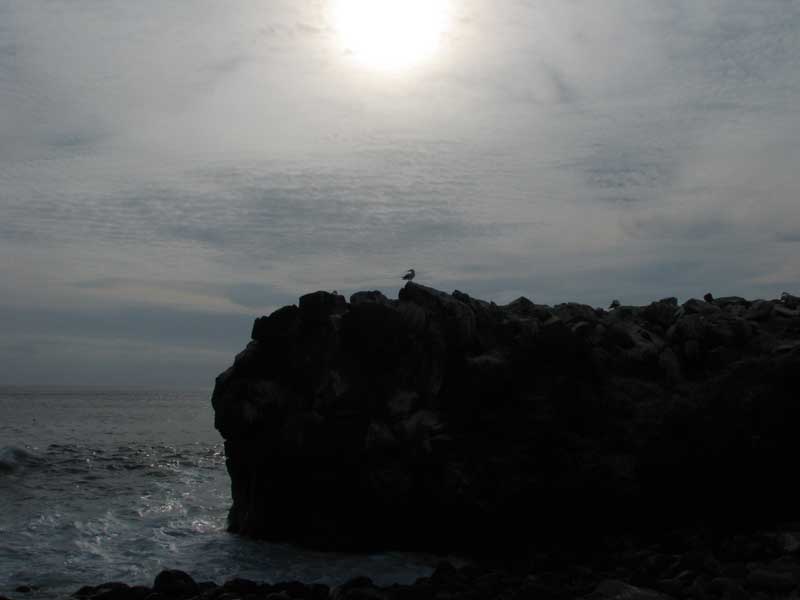

There were also a ton of sea lions again, and this time they weren't just wading in the ocean, they were surfing. We are both very jealous of sea lions – they lounge around on the beach, wade in the surf, play with the tourists, and surf all day long, plus there is a seemingly endless supply of fish and almost no predators for the adults. We also saw two male lava lizards competing for territory. They get near one another, then do push-ups to show off their manhood. Our two fought a little bit, but then just preened for awhile without any further squabbling, so we walked on. At the end of the trail we saw a blowhole.
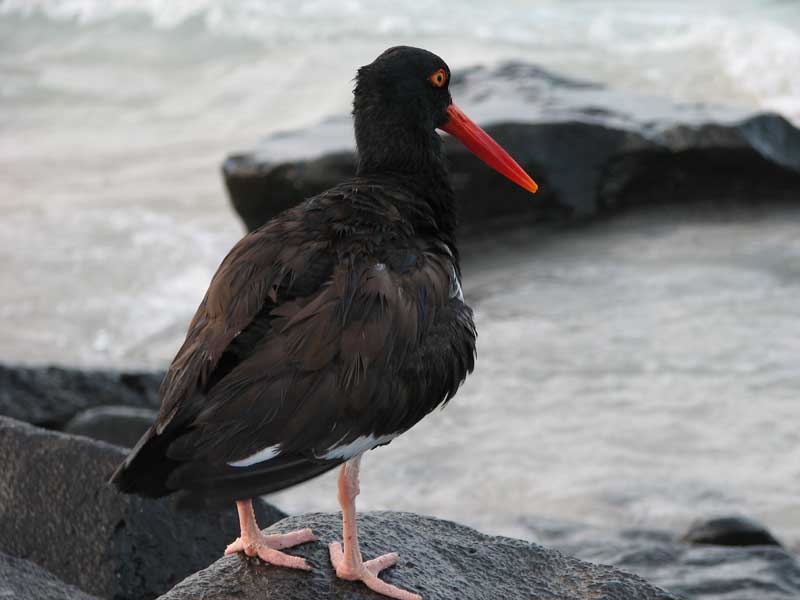
At the end of the trail Willy told us about the albatrosses, even though they weren't there for us to see. They start showing up at the end of March and early April. We had seen some shows on the Albatrosses before we left, and we couldn't wait to see them, especially their mating ritual. Pairs have a very long, very intricate, mating dance that involves beak tapping, mooing, and dancing around in perfect synchronization. It is really beyond description – you have to see it. Alas, we could not see it in person. We'll have to come back. In an attempt to make ourselves feel better about missing out, we asked Willy if we saw something that wasn't usually going on, and he told us that we came at the perfect time for the red-throated displays of the male Frigate Birds. We did feel better, but we also decided that we need to come back some year in May to see the Albatrosses.
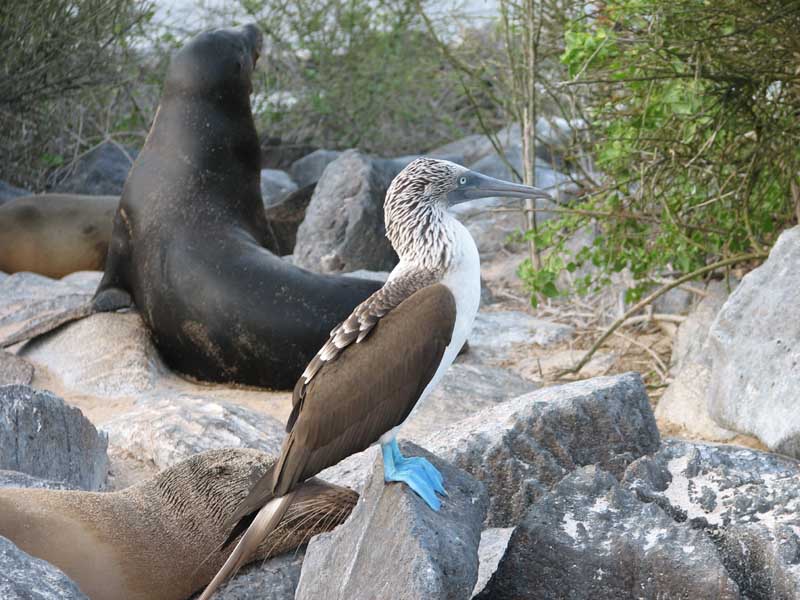

Back on the boat, we had some drinks and discussed travel with Martha and Kate. They wanted to know about our trip to Southeast Asia last year, and Martha told us about how she wanted to go to Mongolia and some interesting books she had read involving Mongolia . She also told us that Lake Baykal in Russia was not just a summer tourist destination, but that there are snow and ice things to do during winter. If we ever do go to Lake Baykal , though, it will still probably be in the summer.
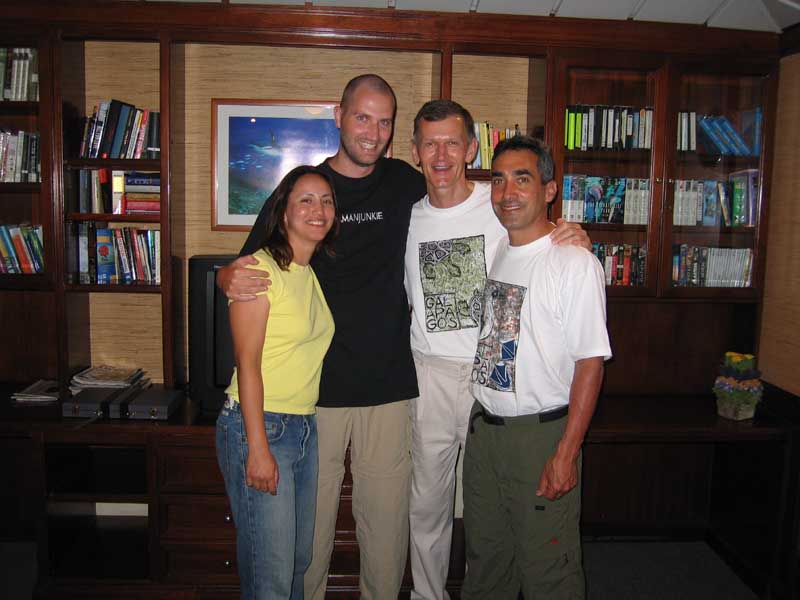
We had dinner, then went stargazing. Because the Galapagos is along the equator, both the northern and southern constellations are visible. We had heard about the Southern Cross, and wanted to see it – we were wildly underwhelmed. It was just four stars, and doesn't really look like a cross – if you connect the dots it forms a diamond, not a cross. Anyway, there were a lot of stars, but not nearly as many as we saw atop Mauna Kea on the Big Island in Hawaii. We took some photos with some of the other guests, including John and Phillip, and then packed before going to sleep.